Paul Gilster's Blog, page 125
July 18, 2017
Making Optical SETI Happen
Yesterday I made mention of the Schwartz and Townes paper “Interstellar and Interplanetary Communication by Optical Masers,” which ran in Nature in 1961 (Vol. 190, Issue 4772, pp. 205-208). Whereas the famous Cocconi and Morrison paper that kicked off radio SETI quickly spawned an active search in the form of Project Ozma, optical SETI was much slower to develop. The first search I can find is a Russian project called MANIA, in the hands of V. F. Shvartsman and G. M. Beskin, who searched about 100 objects in the early 1970s, finding no significant brightness variations within the parameters of their search.

If you want to track this one down, you’ll need a good academic library, as it appears in the conference proceedings for the Third Decennial US-USSR Conference on SETI, published in 1993. Another Shvartsman investigation under the MANIA rubric occurred in 1978. Optical SETI did not seem to seize the public’s imagination, perhaps partially because of the novelty of communications through the recently discovered laser. We do see several optical SETI studies at UC-Berkeley’s Leuschner Observatory and Kitt Peak from 1979 to 1981, the work of Francisco Valdes and Robert Freitas, though these were searches for Bracewell probes within the Solar System rather than attempts to pick up laser transmissions from other star systems.
Image: Harvard’s Paul Horowitz, a key player in the development of optical SETI. Credit: Harvard University.
This was an era when radio searches for extraterrestrial technology had begun to proliferate, but despite the advocacy of Townes and others (and three conferences Townes helped create), it wasn’t until the 1990s that optical SETI began to come into its own. Charles Townes himself was involved in a search for laser signals from about 300 nearby stars in the ‘90s, using the 1.7-meter telescope on Mt. Wilson and reported on at the 1993 conference. Stuart Kingsley began an optical SETI search using the 25-centimeter telescope at the Columbus Optical SETI Observatory (COSETI) in 1990, while Gregory Beskin searched for optical signals at the Special Astrophysical Observatory run by the Russian Academy of Sciences in the Caucasus in 1995.
Optical SETI’s advantages were beginning to be realized, as Andrew Howard (Caltech) commented in a 2004 paper:
The rapid development of laser technology since that time—a Moore’s law doubling of capability roughly every year—along with the discovery of many microwave lines of astronomical interest, have lessened somewhat the allure of hydrogen-line SETI. Indeed, on Earth the exploitation of photonics has revolutionized communications technology, with high-capacity fibers replacing both the historical copper cables and the long-haul microwave repeater chains. In addition, the elucidation (Cordes & Lazio 1991) of the consequences to SETI of interstellar dispersion (first seen in pulsar observations) has broadened thinking about optimum wavelengths. Even operating under the prevailing criterion of minimum energy per bit transmitted, one is driven upward to millimetric wavelengths.

In the late 90’s, the SETI Institute, as part of a reevaluation of SETI methods, recommended and then co-funded several optical searches including one by Dan Werthimer and colleagues at UC Berkeley and another by a Harvard-Smithsonian team including Paul Horowitz and Andrew Howard. The Harvard-Smithsonian group also worked in conjunction with Princeton University on a detector system similar to the one mounted on Harvard’s 155-centimeter optical telescope. A newer All-Sky Optical SETI (OSETI) telescope, set up at the Oak Ridge Observatory at Harvard and funded by The Planetary Society, dates from 2006.
Image: Dan Werthimer, chief scientist at the Berkeley SETI Research Center. Credit: UC-Berkeley.
At Berkeley, the optical SETI effort is led by Werthimer, who had built the laser detector for the Harvard-Smithsonian team. Optical SETI efforts from Leuschner Observatory and Lick Observatory were underway by 1999. Collaborating with Shelley Wright (UC Santa Cruz), Remington Stone (UC Santa Cruz/Lick Observatory), and Frank Drake (SETI Institute), the Berkeley group has gone on to develop new detector systems to improve sensitivity. As I mentioned yesterday, UC-Berkeley’s Nate Tellis, working with Geoff Marcy, has analyzed Keck archival data for 5,600 stars between 2004 and 2016 in search of optical signals.
Working in the infrared, the Near-Infrared Optical SETI instrument (NIROSETI) is designed to conduct searches at infrared wavelengths. Shelley Wright is the principal investigator for NIROSETI, which is mounted on the Nickel 1-meter telescope at Lick Observatory, seeing first light in March of 2015. The project is designed to search for nanosecond pulses in the near-infrared, with a goal “to search not only for transient phenomena from technological activity, but also from natural objects that might produce very short time scale pulses from transient sources.” The advantage of near-infrared is the decrease in interstellar extinction, the absorption by dust and gas that can sharply impact the strength of a signal.
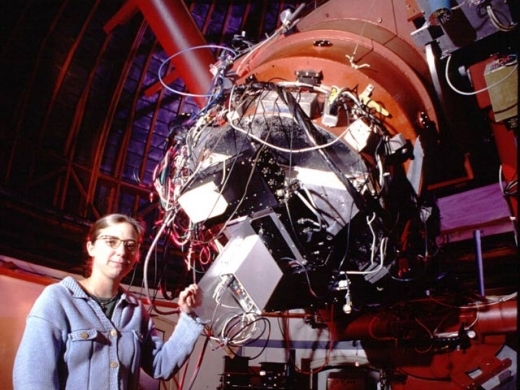
Image: Shelley Wright, then a student at UC-Santa Cruz, helped build a detector that divides the light beam from a telescope into three parts, rather than just two, and sends it to three photomultiplier tubes. This arrangement greatly reduces the number of false alarms; very rarely will instrumental noise trigger all three detectors at once. The three-tube detector is in the white box attached here to the back of the 1-meter Nickel Telescope at Lick Observatory. Credit: Seth Shostak.
I might also mention METI International’s Optical SETI Observatory at Boquete, Panama. The idea is to put the optical SETI effort in context. With the SETI Institute now raising money for its Laser SETI initiative — all-sky all-the-time — the role of private funding in making optical SETI happen is abundantly clear. And now, of course, we also have Breakthrough Listen, which in addition to listening at radio wavelengths at the Parkes instrument in Australia and the Green Bank radio telescope in West Virginia, is using the Automated Planet Finder at Lick Observatory to search for optical laser transmissions. Funded by the Breakthrough Prize Foundation, the project continues the tradition of private funding from individuals, institutions (the SETI Institute) and organizations like The Planetary Society to get optical SETI done.






July 17, 2017
Detection Possibilities for Optical SETI
The Laser SETI campaign we looked at on Friday is one aspect of a search for intelligent life in the universe that is being addressed in many ways. In addition to optical methods, we look of course at radio wavelengths, and as we begin to characterize the atmospheres of rocky exoplanets, we’ll also look for signs of atmospheric modification that could indicate industrial activity. But we have to be careful. Because SETI looks for evidence of alien technology, it is a search for civilizations about whose possible activities we know absolutely nothing.
So we can’t make assumptions that might blind us to a detection. Getting the blinders off also means extending our reach. If successful, the Laser SETI project will do two things we haven’t been able to do before — it will scan the entire sky and, because it is always on, it will catch optical transients we are missing today, and tell us whether any of these are repeating.
In radio terms, think of the famous WOW! signal of 1977, detected at Ohio State University’s Big Ear radio telescope. Seeming to come out of the constellation Sagittarius, it fit our ideas of what an extraterrestrial signal could look like, but we can’t draw any conclusions because we’ve never seen it again. If the signal intrigues you, Robert Gray’s book The Elusive WOW (Palmer Square, 2011) goes into it in great depth, including Gray’s 1987 and 1989 attempts to find it. Gray would search again in the mid 90’s using the Very Large Array, and again in 1999 with the University of Tasmania’s Mount Pleasant Radio Observatory, with null results.
The Elusive WOW is a splendid page-turner that captures the drama of the hunt. It also reminds us how frustrating a transient can be — here today, gone in moments, never seen again. Did the WOW signal reappear at some time that we weren’t pointing our instruments at it? Is it repeating on some schedule we haven’t figured out?

All-sky surveys like Laser SETI weren’t on the mind of Giuseppe Cocconi and Philip Morrison when they wrote their ground-breaking paper “Searching for Interstellar Communications” in Nature (1959), one that is mostly commonly cited as launching SETI. But for optical SETI’s origins, we can look back with equal admiration at R. N. Schwartz and Charles Townes’ “Interstellar and Interplanetary Communication by Optical Masers,” which ran two years later in the same journal. The author’s vision encapsulates the idea:
We propose to examine the possibility of broadcasting an optical beam from a planet associated with a star some few or some tens of light-years away at sufficient power-levels to establish communications with the Earth. There is some chance that such broadcasts from another society approximately as advanced as we are could be adequately detected by present telescopes and spectrographs, and appropriate techniques now available for detection will be discussed. Communication between planets within our own stellar system by beams from optical masers appears a fortiori quite practical.
Image: Charles Hard Townes, at the National Institute of Biomedical Imaging and Bioengineering’s 5th Anniversary Symposium, held in June 2007. Credit: NIBIB.
Optical SETI Scenarios
We saw Friday that a petawatt laser of the kind that has been built at Lawrence Livermore National Laboratory could be transformed into an optical SETI beacon, working in conjunction with a huge mirror like that found on our largest telescopes. Indeed, the Sun can be outshone by a factor of 10,000, a bright and, one would assume, obviously artificial beacon. But the complexities involved in targeting another star — and aiming the beam to lead the moving target, one that will be many light years away, make targeted laser beacons difficult.
Surely the challenges of laser beacons — not to mention their cost — could be overcome by advanced civilizations, although the idea of a less targeted beacon seems to make more sense; i.e., a beacon that sweeps a region of the sky on a recurrent basis, assuming the intent here is simply to announce the presence of the extraterrestrial civilization as widely as possible. But perhaps it’s much more likely that, if we do detect a laser signal from another civilization, it will be in the form of a chance interception of a technology at work.
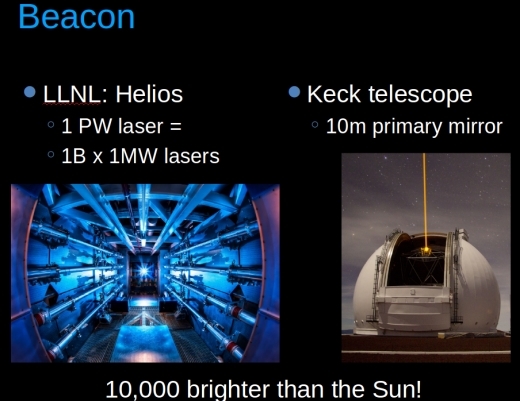
Image: The power of laser technology even today. Credit: Eliot Gillum/SETI Institute.
Detecting communications within an exoplanetary system presents serious problems of geometry, given that these optical beams would be broadcast to specific targets and are unlikely to be pointing by chance at the Earth. But there is a scenario that could work: We’ve learned all about exoplanet detection through planetary transits from the Kepler mission. A planetary system that was co-planar with our own could produce a communications beam between its own planets that swept past us with each orbital revolution. Even then, the target planet would likely absorb enough of the signal that detection would be unlikely.
But there are other kinds of detections. James Guillochon and Abraham Loeb have looked at the possibility that beaming to interstellar sailcraft would produce leakage that might be observable to our detectors (see SETI via Leakage from Light Sails in Exoplanetary Systems). Both interplanetary as well as interstellar transportation systems leave possible signatures.
And consider Boyajian’s Star (KIC 8462852), whose odd light curves drew it to the attention of citizen scientists at the Planet Hunters project and subsequent worldwide scrutiny. Numerous natural phenomena have been put forward to explain what we are seeing here, but light curves like this could also be the sign of an extraterrestrial civilization working on some kind of massive project (a Dyson sphere inevitably comes to mind, but who knows?)
It made sense, then, to make Boyajian’s Star a SETI target, which is why the SETI Institute used the Allen Telescope Array to search for radio emissions, a two-week survey that produced no evidence of artificial radio signals coming from the system. For more on this investigation, see Jim and Dominic Benford’s Quantifying KIC 8462852 Power Beaming, which analyzed the ATA results at radio wavelengths. But note the following, which summarizes what the Benfords believe would be detectable given the instruments used in the attempt. As you can see, not all detectable signals would come from power beamed, for example, to an interstellar mission. Some of them definitely include applications within the target system:
Orbit raising missions, which require lower power, are not detectable at the thresholds of the Allen Array.
Launch from a planetary surface into orbits would be bright enough to be seen by the 100 kHz observations. However, the narrow bandwidth 1 Hz survey would not see them.
Interplanetary transfers by beam-driven sails should be detectable in their observations, but are not seen. This is for both the narrow 1 Hz and for the “wideband” 100 kHz observations.
Starships launched by power beams with beamwidths that we happen to fall within would be detectable, but are not seen.

Image: Power beaming to drive an interstellar lightsail. Credit: Adrian Mann.
But let’s move back into the optical. Nate Tellis (UC-Berkeley) recently worked with astronomer Geoff Marcy to analyze Keck data archives on 5,600 stars observed between 2004 and 2016, using a computer algorithm fine-tuned to detect laser light (see A Search for Laser Emission with Megawatt Thresholds from 5600 FGKM Stars,” preprint here). The search was an excellent way to put thousands of hours of accumulated astronomical data to work — who knows what discoveries may lurk within such datasets? As a part of the effort, the astronomers studied Boyajian’s Star, again finding no detectable signals. Potential candidates that did emerge in the survey all turned out to be the result of natural processes.
But power beaming is a possible observable as any local civilization goes about moving things around in its own system. Leakage from a beamed power infrastructure is something we’ve focused on here frequently (see, for example, Power Beaming Parameters & SETI re KIC 8462852). Power beaming could be what enables a space-based infrastructure, one that would be capable of large-scale engineering and also of producing the kind of power beams that could drive spacecraft at high velocity to other stars.
But we needn’t exclude communications entirely. Jim Benford has pointed out that any civilization using large-scale power beaming would be aware that its activities could be visible to others. If it had the desire to communicate on such a random basis, the ETI civilization could embed a message within the beam. A kind of interstellar message in a bottle, thrown into the cosmic sea with each sweeping power beam that does local work.
All of this should reinforce the key issue that the Laser SETI project addresses — such beams, working within their own planetary system, would appear in our sky as transients. We return to the core issue, the need for an all-sky survey that observes continuously. Making no assumptions about any desire to communicate, such a survey nonetheless is capable of spotting the signs of a working civilization going about its business. It should, I would wager, also pick out new astrophysical phenomena that will add to our knowledge of the galaxy.






July 14, 2017
Laser SETI: All Sky All the Time
The SETI Institute’s just announced Laser SETI funding campaign intends to put into practice what SETI researchers have been anticipating for decades, an all-sky, all-the-time observing campaign. The Institute’s Eliot Gillum and Gerry Harp are behind the project, backed by an impressive list of advisors, with the intention of using optical SETI methods to look for signs of extraterrestrial civilizations. In doing so, they’re reminding us how we’ve done SETI, how we can surmount its current limitations, and what a SETI of the future will look like.
Think about how SETI has evolved since the days when Frank Drake created Project Ozma at the National Radio Astronomy Observatory at Green Bank (WV). Fresh with the insights of Giuseppe Cocconi and Philip Morrison, who examined radio methods and suggested a search for signals near the 21 centimeter wavelength of neutral hydrogen, Drake turned a 26-meter radio telescope to examine the nearby Sun-like stars Tau Ceti and Epsilon Eridani.
Would SETI be a matter of looking at specific stars at certain wavelengths? Immediately the list of questions began to grow. Once you have chosen a target (and there are 18 million stars within 1000 light years), how long do you need to examine it before moving on to another? For that matter, are radio wavelengths optimal? And if our method is to look at particular places at particular times, how would we detect periodic signals that are on no schedule we can hope to predict? What do we miss in between?
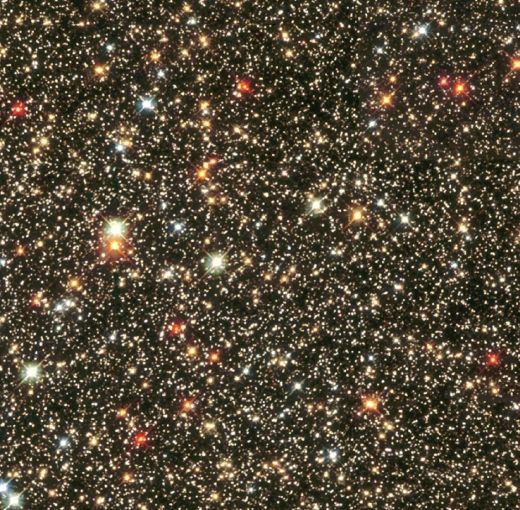
Image: The view toward Messier 24, the Sagittarius star cloud. We are looking for signals amidst immensity. Credit: Hubble Heritage Team (AURA/ STScI/ NASA).
All Sky All the Time
We started doing SETI at radio wavelengths at a time when there were no operational lasers, but today we can look at the experience of our own civilization to see how high-capacity fibers have changed the way we communicate. As we add laser methods to SETI, we begin looking for the kind of monochromatic optical signal that nature does not tend to produce. We also look on timescales of nanoseconds, for no natural sources produce nanosecond pulses.
Configured to serve as a beacon, the Helios laser at Lawrence Livermore National Laboratory could outshine our own Sun by a factor of 10,000. Couldn’t an ET civilization do the same?
But of course we have no way of making assumptions about what an alien civilization might do. We may not receive a beacon at all. We may find ourselves intercepting alien communications or activities like power beaming that produce optical signatures but are not intended as communications. For that matter, here on Earth we use powerful radars (think Arecibo) to examine near-Earth asteroids as we assess impact possibilities. The beams from these searches should be detectable, but would appear in an alien sky as a transient.
So we have to get away from the assumption that any extraterrestrial civilization will be ‘always on,’ just waiting for us to detect it. Searching with instruments pointed at specific targets and limited by short ‘dwell’ times (how long we remain on that target), we wouldn’t find the great bulk of transients that could be telltale evidence of other civilizations. We’re just now learning, for example, about Fast Radio Bursts (FRBs), millisecond radio pulses thought to occur in their thousands every day and still poorly understood. Because they appear as transients, we’ve only catalogued a handful. SETI sometimes detects radio transients that never, to our knowledge, reoccur. Or perhaps some do, but we aren’t looking then.
Current methods are, to use Paul Shuch’s phrase, looking at the sky through a soda straw. Laser SETI proposes to put an end to that limitation with new detectors that will become the basis of observatories that will one day provide global coverage of the entire sky.
Moreover, the detector Eliot Gillum talked about in last year’s Breakthrough Discuss meeting, is not hypothetical. The design has been turned into a prototype and tested with sky observations to validate the methods and analyze performance. The Laser SETI campaign on Indiegogo seeks to raise the funds needed to produce a minimum of two cameras, enough to localize targets on the sky and examine the algorithms used in signal detection.
Pushing Imaging Technologies in SETI’s Direction
Laser SETI’s technology involves cameras with a wide field of view that use ‘drift scanning’ methods (a fixed camera tracking the celestial scene as it passes above). The camera is a charged coupled device (CCD), a familiar technology widely used not only in astronomical observations but also in cell phone cameras and numerous scientific applications. Photons striking a CCD’s light-sensitive elements generate a charge that can be read by electronics within the device and turned into a digital copy of the light falling onto the surface.
But that just begins the story. Remember, we’re talking about the night sky moving across the camera’s fixed field of view. Laser SETI thus incorporates what is called Time-Delay Integration (TDI), a CCD readout technique used in many applications to capture images of fast-moving objects. TDI can preserve both sensitivity and image quality even when dealing with fast relative movement, with photo-charges constantly being shifted down the CCD detector from pixel to pixel as they record changes to the light pattern being observed.
In TDI work as it is normally used — this might be, for example, in factories for quality control — the shift rate within the CCD matches the rate of the target being imaged. But Laser SETI’s new technology uses TDI in an entirely novel way. Instead of producing a normal working image, the idea is to overclock the TDI so that the ‘scene’ — the sky above — becomes smeared out and spread over the entire CCD. The beauty of this is that while the background sky loses definition, any transient pulses that appear show up as a single point.
Reading out the camera at over 1000 times per second, the detector also employs a transmission grating that spreads each point source into two spectra, allowing a single color of light to be distinguished from other kinds of sources. Gillum and Harp’s methods demand two cameras, the second looking at the same field of view but turned 90 degrees sideways. The coordination between the two instruments allows the software to recover accurate sky coordinates for any transient being observed. Putting four cameras at a given site, coupled the same way (two per field of view), allows the entire night sky to be covered.
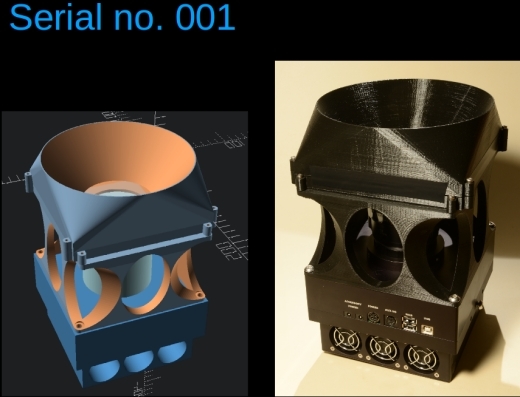
Image: The first detector. The CCD camera is at the base, the lens atop it, and the transmission grating at the top beneath the hood. Two of the major three components here are off-the-shelf, keeping costs low. Credit: SETI Institute/Eliot Gillum.
Moving Laser SETI Worldwide
You can see what all this is building toward. The Indiegogo project’s intent is to raise the money for two cameras, but further funding takes us toward multiple site operations. The entire sky can’t be seen from any one part of the globe, but six observatories could cover all of it, with eventual secondary observatories adding valuable statistical validation, and also necessary sky coverage during times when the weather is inclement at any one site.
Have a look at the Laser SETI campaign for further background. The low cost of these detectors is significant. And bear this in mind. When we look at particular points in the sky, we have to be lucky enough that the signal we seek is available just then, just there. Looking everywhere all the time, we see the brightest signals in the sky whenever they appear.
In the entire history of radio astronomy, it has taken us until now to detect Fast Radio Bursts. What else are we missing? As Eliot Gillum pointed out in a recent presentation, we have no way of knowing what any extraterrestrial civilization may be doing, but we can say this: If their activity is bright but intermittent, all previous and current searches very likely won’t find it.
That’s why we need to look at the entire sky all the time.






July 13, 2017
Citizen Scientist Imagery of the Great Red Spot
All of the Juno spacecraft’s instruments — including JunoCam — were operational during its July 10 flyby, giving us a close-up look at the Great Red Spot. Now 16,000 kilometers wide, the storm has been studied since 1830 and may be considerably older than that. Juno’s orbit took it to perijove (closest to Jupiter’s center) at 2155 EDT on the 10th (0155 UTC on the 11th), when it closed to about 3500 kilometers above the cloud tops. The passage across the Great Red Spot occurred eleven minutes later at some 9000 kilometers above the clouds.
While the data are being unpacked and analyzed, we can enjoy the efforts of citizen scientists who went to work on the raw images posted on the JunoCam site and processed them, a procedure done in coordination with the Juno team.
“These highly-anticipated images of Jupiter’s Great Red Spot are the ‘perfect storm’ of art and science. With data from Voyager, Galileo, New Horizons, Hubble and now Juno, we have a better understanding of the composition and evolution of this iconic feature,” said Jim Green, NASA’s director of planetary science. “We are pleased to share the beauty and excitement of space science with everyone.”

Image: This enhanced-color image of Jupiter’s Great Red Spot was created by citizen scientist Jason Major using data from the JunoCam imager on NASA’s Juno spacecraft. The image was taken on July 10, 2017 at 07:10 p.m. PDT (10:10 p.m. EDT), as the Juno spacecraft performed its 7th close flyby of Jupiter. At the time the image was taken, the spacecraft was about 13,917 kilometers from the tops of the clouds of the planet. Credit: NASA/JPL-Caltech/SwRI/MSSS/Jason Major.
And let’s go through the two others just posted by JPL.The one below was created by Kevin Gill, likewise working with raw data from the JunoCam imager.
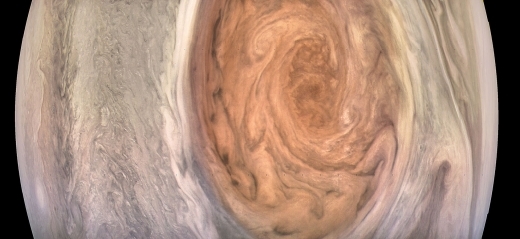
And a final image from citizen scientist Gerald Eichstädt.
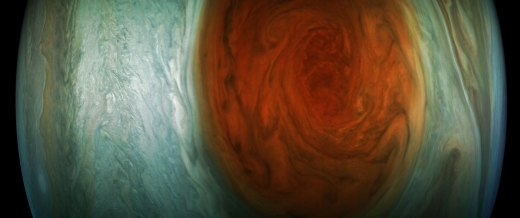
The English natural philosopher Robert Hooke (1635-1703) described what may have been the Great Red Spot in 1664, although he seems to have placed it on the wrong side of the Jovian equator, making the sighting problematic. The following year, however, Giovanni Cassini detected a ‘permanent storm’ that remained under observation into the 18th Century, although there are no observations between 1713 and 1830. The first certain record of the Great Red Spot occurs in an 1831 drawing by German amateur Samuel Heinrich Schwabe.
The red coloration of the Great Red Spot is problematic, with suggestions ranging from compounds of sulfur and phosphorus to organic material produced by high-altitude photochemical reactions or lightning discharges. The Voyager spacecraft returned spectacular imagery, including the Voyager 1 image in 1979 shown below, which revealed details as small as 160 kilometers and highlighted the spectacularly complex wave motion west of the Spot.

Image: Jupiter’s Great Red Spot (top right) and the surrounding region, as seen from Voyager 1 on March 1, 1979. Below the spot is one of the large white ovals associated with the feature. NASA/JPL
Since the Voyager encounters (and indeed, since the late 19th Century) the Spot has been shrinking. Voyager measured its length at 23,000 kilometers, and since 2012 it has been diminishing at a rate of about 900 kilometers per year. We’ll see what Juno can tell us about the giant storm’s energy source and its longevity as data are processed in the weeks ahead.






July 12, 2017
A Binary ‘Rogue’ Planet?
‘Planetary mass binary’ is an unusual term, but one that seems to fit new observations of what was thought to be a brown dwarf or free-floating large Jupiter analog, and now turns out to be two objects, each of about 3.7 Jupiter masses. That puts them into planet-range when it comes to mass, as the International Astronomical Union normally considers objects below the minimum mass to fuse deuterium (13 Jupiter masses) to be planets. This is the lowest mass binary yet discovered.
A team led by William Best (Institute for Astronomy, University of Hawaii) went to work on the L7 dwarf 2MASS J11193254–1137466 with the idea of determining what they assumed to be the single object’s mass and age. It was through observations with the Keck II telescope in Hawaii that they discovered the binary nature of their target. The separation between the two objects is about 3.9 AU, based upon the assumption that the binary is around 160 light years away, the distance of the grouping of stars called the TW Hydrae Association.
Let’s pause on this for a moment. The TW Hydrae Association has come up in these pages in the past, as a so-called ‘moving group’ that contains stars that share a common origin, and thus are similar in age and travel through space together. Moving groups are obviously useful — if astronomers can determine that a star is in one, then its age and distance can be inferred from the other stars in the group. Best and colleagues determined from key factors like sky position, proper motion, and radial velocity that there was about an 80 percent chance that 2MASS J11193254–1137466AB is a member of the TW Hydrae Association.
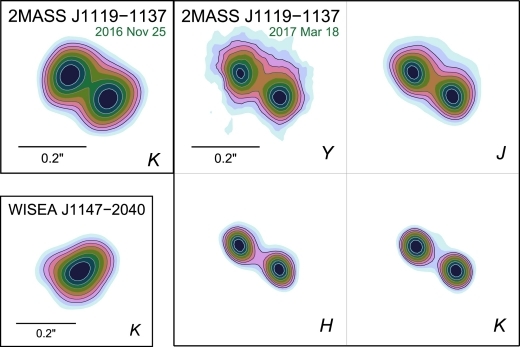
Image: Keck images of 2MASS J11193254–1137466 reveal that this object is actually a binary system. A similar image of another dwarf, WISEA J1147-2040, is shown at bottom left for contrast: this one does not show signs of being a binary at this resolution. Credit: Best et al. 2017.
Determining a brown dwarf’s age is tricky business because these objects cool continuously as they age, which means that brown dwarfs of different masses and ages can wind up with the same luminosity. The authors point out that this mass-age-luminosity degeneracy makes it hard to figure out their characteristics without knowing at least two of the three parameters. Membership in a moving group like the TW Hydrae Association gives us an age of about 10 million years but also provides mass estimates from evolutionary models.
And a binary system hits the jackpot, for now we can study the orbits of the two objects to work out model-independent masses, which is how Best drilled down to the 3.7 Jupiter mass result for each binary member here. The authors consider the binary a benchmark for tests of evolutionary and atmospheric models of young planets, and go on to speculate about its possible origins:
The isolation of 2MASS J1119−1137AB strongly suggests that it is a product of normal star formation processes, which therefore must be capable of making binaries with ≲ 5 MJup components. 2MASS J1119−1137AB could be a fragment of a higher-order system that was ejected via dynamical interactions (Reipurth & Mikkola 2015), although the lack of any confirmed member of TWA within 10° (projected separation ≈ 5 pc) of 2MASS J1119−1137 makes this scenario unlikely. Formation of very low mass binaries in extended massive disks around Sun-like stars followed by ejection into the field has been proposed by, e.g., Stamatellos & Whitworth (2009), but disks of this type have not been observed.

Image: The positions of 2MASS J11193254–1137466A and B on a color-magnitude diagram for ultracool dwarfs. The binary components lie among the faintest and reddest planetary-mass L dwarfs. Credit: Best et al. 2017.
So there is much to learn here. An object’s composition, temperature and formation history all come into play when determining whether it is a brown dwarf or a planet, and some definitions of brown dwarf take us below the 13 Jupiter mass criteria. But at 3.7 Jupiter masses, these objects clearly warrant the authors’ careful tag of ‘planetary mass binary.’
The paper is Best et al., “The Young L Dwarf 2MASS J11193254−1137466 Is a Planetary-mass Binary,” Astrophysical Journal Letters Vol. 843, No. 1 (23 June 2017). Available online.






July 11, 2017
Terrain Clues to Ice in the Outer System
The human expansion into the Solar System will demand our being able to identify sources of water, a skill we’re honing as explorations continue. On Mars, for example, the study of so-called ‘pitted craters’ has been used as evidence that the low latitude regions of the planet, considered its driest, nonetheless have a layer of underlying ice. The Dawn spacecraft discovered similar pitted terrain on Vesta, as you can see in the image below.
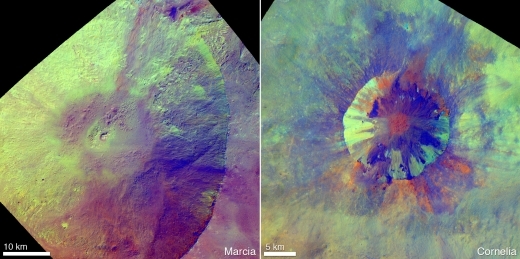
Image: These enhanced-color views from NASA’s Dawn mission show an unusual “pitted terrain” on the floors of the craters named Marcia (left) and Cornelia (right) on the giant asteroid Vesta. The views show that the physical properties or composition of the material in which these pits form is different from crater to crater. Credit: NASA/JPL-Caltech/UCLA/MPS/DLR/IDA/JHUAPL.
Vesta’s Marcia crater contains the largest number of pits on the asteroid. The 70-kilometer feature is also one of the youngest craters found there. So what accounts for this kind of terrain? Perhaps the water that formed the pits came from Vesta itself. Another possibility: Low-speed collisions with carbon-rich meteorites could have deposited hydrated materials on the surface, to be released in the heat of subsequent high-speed collisions within the asteroid belt. An explosive degassing into space could explain such pothole-like depressions.
But Dawn wasn’t through when it left Vesta, and what it has found at Ceres is proving invaluable at understanding what appears to be a common marker of volatile-rich material. In new work from Hanna Sizemore (Planetary Science Institute) and colleagues, we learn that Ceres is home to the same kind of pitted terrain. As Sizemore notes:
“Now, we’ve found this same type of morphological feature on Ceres, and the evidence suggests that ice in the Cerean subsurface dominated the formation of pits there. Finding this type of feature on three different bodies suggests that similar pits might be found on other asteroids we will explore in the future, and that pitted materials may mark the best places to look for ice on those asteroids.”
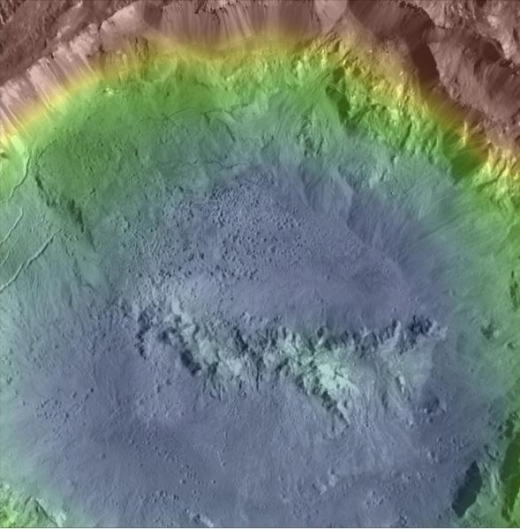
Image: Haulani Crater, Ceres, showing abundant pitted materials on the crater floor. Similar pitted materials have previously been identified on Mars and Vesta, and are associated with rapid volatile release following impact. Their discovery on Ceres indicates pitted materials may be a common morphological indicator of volatile-rich materials in the asteroid belt. Haulani Crater is 34 km in diameter. Color indicates topography. Credit: NASA/MPS/PSI/Thomas Platz.
Sizemore’s team studied the formation of pitted craters on Ceres through numerical models that explored the role of water ice and other volatiles. The morphological similarities between the Ceres features and what has been found on Mars and Vesta are striking. With water ice evidently significant in pit development on two asteroids and a planet, similar terrains will be of clear interest for future missions in terms of in situ resource utilization.
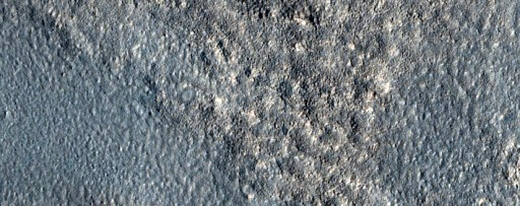
Image: Pitted terrain on Mars as seen by HiRISE aboard the Mars Reconnaissance Orbiter. Credit: NASA/JPL/University of Arizona.
The paper is Sizemore et al., “Pitted Terrains on (1) Ceres and Implications for Shallow Subsurface Volatile Distribution,” accepted at Geophysical Research Letters (preprint).






July 10, 2017
Toward a Planet Formation Model for Pulsars
Our theories of planet formation grow more mature as the exoplanet census continues, but I’ve always speculated about the first planets discovered and how they could have possibly been where we found them. The discovery of the planets around the pulsar PSR B1257+12 occurred in 1992, the work of the Polish astronomer Aleksander Wolszczan. Anomalies in its pulsation period — this is a millisecond pulsar with a period of 6.22 milliseconds — led Wolszczan and Dale Frail to produce a paper on the first extrasolar planets ever found.
We wouldn’t find such planets at all if it were not for the effect of their gravitational pull on the otherwise regular pulses from the pulsar. But how could the planets now know as Draugr, Poltergeist and Phobetor, the latter found in 1994, possibly have formed in such an environment? After all, a dense neutron star (a pulsar is a highly magnetized, rotating neutron star) is the result of a supernova that should have destroyed any planets nearby, making it necessary for planet formation to occur from raw materials around the resulting object.
Jane Greaves (University of Cardiff), working with Wayne Holland (UK Astronomy Technology Centre, Edinburgh) presented results at the recent National Astronomy Meeting that the duo have assembled into a new paper. The researchers focused on the Geminga pulsar, about 800 light years from the Sun in the constellation Gemini. A quick check of Wikipedia produced this delightful bit about the name Geminga: It’s a contraction of ‘Gemini gamma-ray source’ as well as a transcription of words meaning ‘it’s not there’ in the Lombard dialect of northern Italy.
Geminga really is there, and at one point the explosion that created it was considered the reason for the low density of the interstellar medium through which the Sun now passes, a theory that is now out of favor. Greaves and Holland observed Geminga at submillimeter wavelengths with the James Clerk Maxwell Telescope (JCMT) in Hawaii. The pulsar is surrounded by a pulsar wind nebula (PWN), a type of nebula found inside the shells of supernova remnants that is powered by pulsar ‘winds’ driven by the central pulsar.
Indeed, earlier data from the WISE mission had suggested a ‘shell-like parabolic structure comprising a number of clumps’ around Geminga, and the authors’ new work amplifies on that discovery. Multiple observing runs with different cameras showed Greaves and Holland faint material near the pulsar and an arc around it. Says Greaves:
“This seems to be like a bow-wave – Geminga is moving incredibly fast through our Galaxy, much faster than the speed of sound in interstellar gas. We think material gets caught up in the bow-wave, and then some solid particles drift in towards the pulsar.”
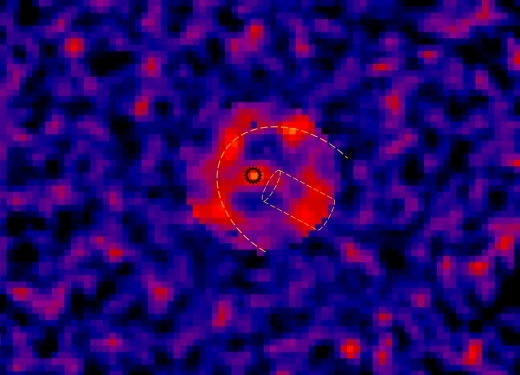
Image: Data at wavelength of 0.45 mm, combined from SCUBA and SCUBA-2 [the cameras used in this work] in a false-colour image. The Geminga pulsar (inside the black circle) is moving towards the upper left, and the orange dashed arc and cylinder show the ‘bow-wave’ and a ‘wake’. The region shown is 1.3 light-years across; the bow-wave probably stretches further behind Geminga, but SCUBA imaged only the 0.4 light-years in the centre. Credit: Jane Greaves / JCMT / EAO.
The hypothesis, then, is that dust from the interstellar medium interacting with the pulsar wind nebula around Geminga accumulates the raw materials for future planets, rather than interactions between the pulsar wind nebula and the pulsar itself. The pulsar’s movement through the interstellar medium is the key, at least for this pulsar. From the paper:
The origins of the rare pulsar planet systems are uncertain, with recent work (Margalit & Metzger 2017) favouring disruption of a companion over re-accretion of supernova fallback material. Here we find evidence that the middle-aged Geminga pulsar is surrounded by a shell of material which could have formed from compression of the local ISM. Preliminary calculations suggest that dust could penetrate the nebula, given the low space speed and local density, and this may provide an alternate source for dust near this pulsar. A candidate circum-pulsar disc would be the first to be found in the submillimetre, complementing the only infrared candidate (around the magnetar 4U 0142+61, Wang et al. 2006).
And the researchers seem to have found enough mass to do the job:
We are waiting for higher-resolution follow-up data, but can infer that any dust disc present around Geminga should exceed about 6 Earth-masses of dust. Thus it would have potential to form low-mass planets, such as the archetypes around PSR B1257+12 (Wolszczan & Frail 1992).
The authors have applied for time on the Atacama Large Millimeter Array (ALMA), hoping to tease out more detail, enough to demonstrate that the faint debris they have spotted so far around Geminga really is associated with the object. A confirmation there would lead to work on other pulsar systems to probe deeper into planet formation in unusual environments.
The paper is Greaves & Holland, “The Geminga pulsar wind nebula in the mid-infrared and submillimetre,” published online by Monthly Notices of the Royal Astronomical Society 15 June 2017 (abstract).






July 7, 2017
How Many Brown Dwarfs in the Milky Way?
Interesting news keeps coming out of the National Astronomy Meeting in the UK. Today it involves brown dwarfs and their distribution throughout the galaxy, a lively question given how recently we’ve begun to study these ‘failed stars.’ Maybe we need a better name than ‘brown dwarfs,’ for that matter, since these objects are low enough in mass that they cannot sustain stable hydrogen fusion in their core. In a murky intermediary zone between planet and star, they can produce planets of their own but straddle all our contemporary definitions.
At the NAS meeting, an international team led by Koraljka Muzic (University of Lisbon) has reported on its work on brown dwarfs in clusters. It seems a sensible approach — go to the places where young stars are forming and try to figure out how many brown dwarfs emerge alongside them. That could help to give us an overview, because the brown dwarfs we’ve already found (beginning with the first, in 1995) are generally within 1500 light years of the Sun. Cluster studies should help us gain some sense of their broader distribution.
Clusters, after all, give birth to all kinds of stars from tens of solar masses down to the brown dwarfs we’re looking for, and the so-called initial mass function (IMF) showing the distribution of the different masses in young clusters has received plenty of attention. A key figure in its earlier study was Edwin Salpeter, an emigrant from Austria to Australia who wound up teaching at Cornell University. His work on the initial mass function led to values still accepted today down to stars of about half a solar mass, but things below that get murkier.
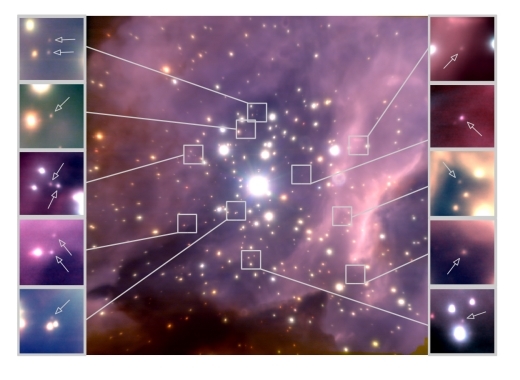
Image: False-colour near-infrared image of the core of the young massive cluster RCW 38 taken with the adaptive-optics camera NACO at the ESO’s Very Large Telescope. RCW 38 lies at a distance of about 5,500 light-years from the Sun. The field of view of the central image is approximately 1 arc minute, or 1.5 light-years across. Credit: Koraljka Muzic, University of Lisbon, Portugal / Aleks Scholz, University of St Andrews, UK / Rainer Schoedel, University of Granada, Spain / Vincent Geers, UKATC Edinburgh, UK / Ray Jayawardhana, York University, Canada / Joana Ascenso, University of Lisbon, University of Porto, Portugal, Lucas Cieza, University Diego Portales, Santiago, Chile. The study is based on observations conducted with the VLT at the European Southern Observatory.
Thus the need to update the IMF in the low mass range, a key part of what Muzic and team call Substellar Objects in Nearby Young Clusters, their survey to examine substellar populations in nearby star-forming regions. Recent studies have indicated that a single underlying initial mass function can explain the ratios of stars to brown dwarfs in the clusters studied. But most of the clusters studied to date have been loose groups of low mass stars.
Having already looked at five nearby star-forming regions, Muzic’s group chose to study brown dwarf formation in more massive, dense embedded clusters and homed in on the more distant cluster RCW 38, some 5500 light years out in the constellation Vela. This is a young cluster (less than a million years) that is twice as dense as the Orion Nebula Cluster and orders of magnitude denser than other nearby star forming regions. Packed with massive stars, it seems the ideal place to determine whether different starting conditions produce a different ratio of brown dwarfs to other types of star.
From the paper:
According to various BD formation theories, stellar density is expected to affect the production of very-low mass objects (high densities favor higher production rate of BDs), as well as the presence of massive OB stars capable of stripping the material around nearby pre-stellar cores until leaving an object not massive enough to form another star. In addition to the theoretical expectations, we discussed several observational hints for environmental differences in the nearby star forming regions from the literature, which, however, require further investigation. To that end, we choose to study a cluster that is several orders of magnitude denser than any of the nearby star forming regions (except for the ONC [Orion Nebula Cluster]), and also, unlike them, rich in massive stars.
Working with adaptive optics observations via the NAOS-CONICA imager at the European Space Agency’s Very Large Telescope, the researchers found values for brown dwarf formation that agreed with other young star-forming regions, even those much less dense. The results were clearcut, as the paper notes:
…leaving no evidence for environmental differences in the efficiency of the production of BDs and very-low mass stars possibly caused by high stellar densities or a presence of numerous massive stars.
And this:
In all regions studied so far, the star/BD ratio is between 2 and ∼ 5, i.e. for each 10 low-mass stars between 2 and 5 BDs are expected to be formed. This is also consistent with estimates of the star/BD ratio in the field (∼ 5; Bihain & Scholz 2016). The sum of these results clearly shows that brown dwarf formation is a universal process and accompanies star formation in diverse star forming environments across the Galaxy.
Interesting indeed! The brown dwarf population of the galaxy, based on this survey, is at least 25 billion and may range as high as 100 billion brown dwarfs, which would mean a brown dwarf for every hydrogen-burning star. The range results from the difficulty in observing such small, faint objects, raising the prospect that even the high number here may be an underestimate. Another cause for the variation: Star formation rates in the Milky Way seem to have been higher in the past. If this is the case, the 100 billion number seems more likely.
And note this: The calculations on the brown dwarf population were derived only for brown dwarfs more massive than 0.03 solar masses. Compare this to Jupiter’s mass, which is 0.00095 that of the Sun. Between the two is a wide range of possibilities.
“It seems that brown dwarfs form in abundance in a variety of star clusters,” says Ray Jayawardhana (York University), a member of the research team. “They are ubiquitous denizens of our Milky Way galaxy.”
The paper is Muzic, et al., “The Low-Mass Content of the Massive Young Star Cluster RCW 38,” submitted to Monthly Notices of the Royal Astronomical Society (preprint).






July 6, 2017
Juno’s Upcoming Run over the Great Red Spot
I love the image of Jupiter below because of the detail — a mosaic of 27 images taken on closest approach by Cassini in 2000, it shows visible features down to 60 kilometers across. Nine images covering the entire planet were acquired in red, green and blue to provide color much like what our eyes would see if we were there. The Great Red Spot, nestled among the clouds of ammonia, hydrogen sulfide and water, is obvious. But we’ll soon learn much more, for the Juno spacecraft is scheduled to fly directly over the Great Red Spot on July 10.

Image: This true color mosaic of Jupiter was constructed from images taken by the narrow angle camera onboard NASA’s Cassini spacecraft on December 29, 2000, during its closest approach to the giant planet at a distance of approximately 10 million kilometers. Credit: NASA/JPL/Space Science Institute.
Launched on August 5, 2011, Juno completed its first year in Jupiter orbit on July 4, a reminder of how well shielded its instruments are in this tough environment. Rick Nybakken is project manager for Juno from JPL:
“The success of science collection at Jupiter is a testament to the dedication, creativity and technical abilities of the NASA-Juno team. Each new orbit brings us closer to the heart of Jupiter’s radiation belt, but so far the spacecraft has weathered the storm of electrons surrounding Jupiter better than we could have ever imagined.”
Indeed. Data collection from the Great Red Spot, a centuries-old, 16,000-kilometer wide storm, will be part of the spacecraft’s sixth science flyby, with perijove (the closest point in the orbit to Jupiter’s center) occurring on July 10 at 0955 EDT (1355 UTC). At this point, Juno will be about 3500 kilometers above the cloud tops. Less than 12 minutes later, the spacecraft will have moved directly above the huge storm, passing about 9000 kilometers above the Great Red Spot’s clouds, with all eight instruments as well as the JunoCam imager active.
Earth-based telescopes have provided continuing observations of Jupiter in coordination with Juno, and on May 18, 2017, both the Gemini North and Subaru telescopes (both on Mauna Kea) simultaneously studied the planet in high resolution at different wavelengths, helping to provide data on atmospheric dynamics at various depths at the Great Red Spot and other regions of Jupiter. The image below was taken at infrared wavelengths, where the Great Red Spot appears brightest and high-altitude clouds and hazes become strikingly evident.
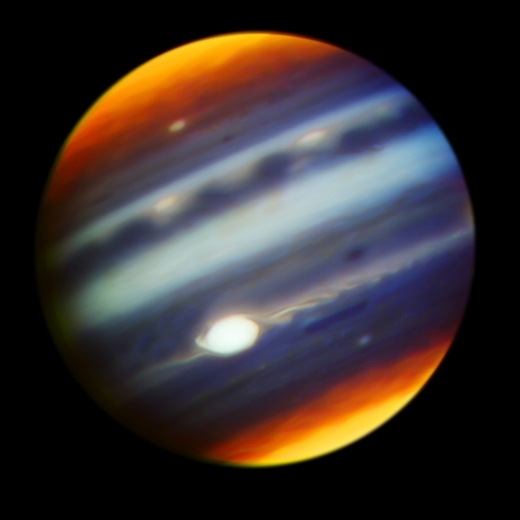
Image: This composite, false-color infrared image of Jupiter reveals haze particles over a range of altitudes, as seen in reflected sunlight. It was taken using the Gemini North Telescope’s Near-InfraRed Imager (NIRI) on May 18, 2017, in collaboration with the investigation of Jupiter by NASA’s Juno mission. Juno completed its sixth close approach to Jupiter a few hours after this observation. Credit: Gemini Observatory/AURA/NASA/JPL-Caltech.
You can see a prominent wave pattern north of the equator, with two bright ovals that are anticyclones that appeared in January of this year. Both are evidently an indication of an upsurge in storm activity that has been observed in these latitudes in 2017. Another bright anticyclonic oval can be seen further north. And note the hook-like shape on the left side of the Great Red Spot, an indication of intense winds stretching out atmospheric features. More traces of this wave-like flow pattern can be seen sweeping off its eastern (right) side.
“Observations with Earth’s most powerful telescopes enhance the spacecraft’s planned observations by providing three types of additional context,” said Juno science team member Glenn Orton of NASA’s Jet Propulsion Laboratory, Pasadena, California. “We get spatial context from seeing the whole planet. We extend and fill in our temporal context from seeing features over a span of time. And we supplement with wavelengths not available from Juno. The combination of Earth-based and spacecraft observations is a powerful one-two punch in exploring Jupiter.”

Image: This false-color image of Jupiter was taken on May 18, 2017, with a mid-infrared filter centered at a wavelength of 8.8 microns, at the Subaru Telescope in Hawaii, in collaboration with observations of Jupiter by NASA’s Juno mission. The selected wavelength is sensitive to Jupiter’s tropospheric temperatures and the thickness of a cloud near the condensation level of ammonia gas. Credit: NAOJ/NASA/JPL-Caltech.






July 5, 2017
174P/Echeclus: Focus on an Unusual Centaur
Centaurs are intriguing objects, and not just because of the problem in figuring out what they are. For one thing, the farthest points in their orbits take them between the orbits of the outer planets in our Solar System. That makes them unstable, yielding lifetimes on the order of a few million years. They also show characteristics of both asteroids and comets, which makes objects like 174P/Echeclus so intriguing. Discovered in 2000, it was classified as a minor planet before a cometary coma appeared. Thus its current cometary designation.
So what exactly do we have here? In 2005, a large piece of 174P/Echeclus broke off, possibly the result of an impact or, despite a distance at the time of over 13 AU from the Sun, perhaps the release of volatiles. We saw another outburst in 2011 at a distance of 8.5 AU from the Sun. Maria Womack (University of South Florida), who is lead author of a new paper on Echeclus, calls it “a bizarre solar system object,” which sounds about right, though other Centaurs — 2060 Chiron and 166P/NEAT — display comas reminiscent of those in comets.
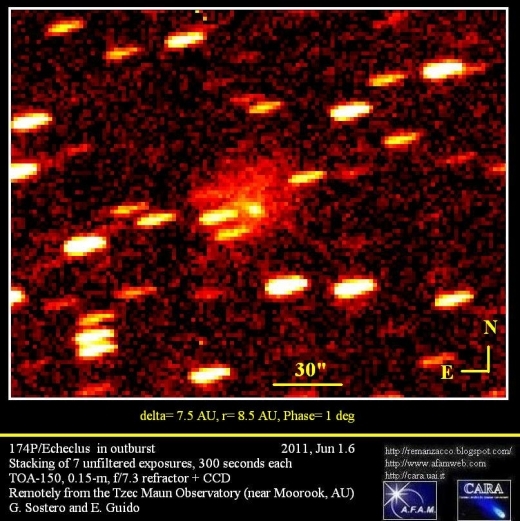
Image: 174P/Echeclus in outburst mode in June of 2011. Credit: G. Sostero/E. Guido. Found at Guido’s excellent Comets & Asteroids site.
That Centaurs are odd objects is further confirmed by the largest confirmed member of their class, 10199 Chariklo, big enough at 260 km in diameter to be a mid-sized asteroid, and known to have a system of rings. We don’t see any comet-like activity here, but two other Centaurs — 52872 Okyrhoe and 2012 CG — have produced what may have been coma activity in the past. Will any Centaur that moves into the inner system become a comet?
For that matter, why do objects like these produce large, observable emissions while still far from the Sun? The average comet, often rich in frozen volatiles like carbon monoxide, carbon dioxide, hydrogen cyanide and methanol, loses ice through sublimation and produces jets of water vapor and other gases only as it approaches the inner system. Perhaps one reason for the difference, the researchers learned, has to do with the composition of Centaurs.
What Womack and team found at Echeclus is that the object shows levels of carbon monoxide nearly 40 times lower than we would expect from comets at similar distances from the Sun. The implication is that this makes Echeclus, and by implication other Centaurs, more fragile than the average comet. The reason for the deficiency of carbon monoxide is unknown, though it may relate to physical processes that caused the CO to be lost.
The researchers used the Arizona Radio Observatory 10-m Submillimeter Telescope to search for CO at Echeclus in mid-2016, when the Centaur was 6.1 AU from the Sun. They found a production rate of carbon monoxide — Q(CO) — which turned out to be the lowest found in any Centaur, and 5 times lower than the carbon monoxide production found near aphelion. The same CO deficiency shows up in other Centaurs. The quoted segment from the paper below refers to Comet Hale-Bopp and the Centaur 29P/Schwassmann-Wachmann 1 (29P) for comparison:
Our data are consistent with Echeclus being a CO-deficient body, when comet Hale-Bopp’s data at ∼ 6 au is used as a proxy for a relatively unprocessed nucleus. When scaled by surface area and compared with CO measurements from other Centaurs, we see that specific production rates, Q(CO)/D2, from Echeclus and Chiron are ∼ 10-50 times below that of Hale-Bopp, and 29P, which are both known to be CO-rich.
But Centaurs will not yield their secrets easily. As the paper continues, we learn that CO deficiency is not a completely shared characteristic:
The lower CO output of Echeclus and Chiron may mean that they incorporated less CO into their nuclei than many other comets, or they may have lost a significant amount due to devolatilization while in their relatively close-to-the-Sun Centaur orbits. It is puzzling why 29P, another Centaur, is evidently CO-rich. Although no other CO detections exist for other Centaurs, stringent upper limits to their specific production rates show that several other Centaurs are also notably absent of CO outgassing, including Chariklo, 8405 Asbolus, 34842 and 95626.
Then bear in mind that we have evidence for fragments, rings and ring arcs around not just 10199 Chariklo but 29P, 2060 Chiron and Echeclus itself. Thus, as the paper points out, we need to make more measurements of CO production rates and fragmentation activity in other Centaurs to refine our models of their structure. The outer Solar System once again reminds us that our categories for these distant objects are subject to continuing revision.
“These are minor bodies that we are studying, but they can provide major insights,” says Gal Sarid (University of Central Florida), a co-author of the paper. “We believe they are rich in organics and could provide important hints of how life originated.”
The paper is Wierzchos, Womack & Sarid, “Carbon Monoxide in the Distantly Active Centaur (60558) 174P/Echeclus at 6 au,” Astronomical Journal Vol. 153, No. 5 (2017). Abstract.






Paul Gilster's Blog
- Paul Gilster's profile
- 7 followers




